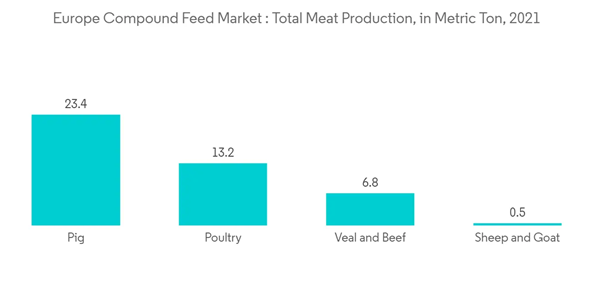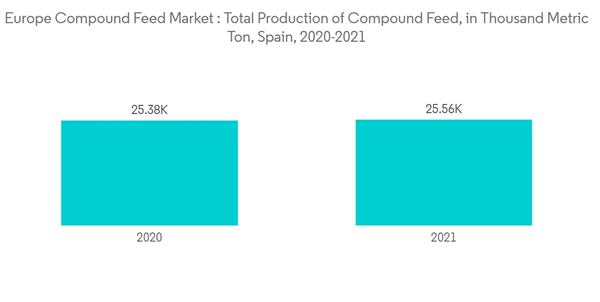Key Highlights
- The market is witnessing favorable trends, such as rising demand for high-protein diets, especially in the Russian and German economies, where per capita income is increasing rapidly. Nevertheless, with the rise in meat consumption worldwide, the compound feed industry is estimated to witness a huge demand for better-quality meat.
- According to the Organisation for Economic Co-operation and Development (OECD) report, demographics, urbanization, incomes, prices, tradition, religious beliefs, cultural norms, and environmental, ethical/animal welfare, and health concerns are key factors that affect not only the level but also the type of meat consumption in the region. It is the main reason meat consumption is projected to increase by 0.4% in Europe.
- The European Feed Manufacturers' Federation (FEFAC) stated that the farm animals in the EU27 consumed an estimated 701 million tons of feed in 2021, of which compound feed manufacturers produced about 22%. The compound feed production in the year 2021, pigs occupied 50,767 thousand metric tons, followed by poultry with 48,924 thousand metric tons, cattle with 42,480 thousand metric tons, and others category occupied 7,033 thousand metric tons.
- According to the Alltech Feed Survey, in 2021, feed production in Europe occupied 261.9 million metric tons in 2020 and held a third rank worldwide to cater to animal nutrition in livestock, poultry, swine, and many others. Feed prices greatly affected producers. Additional challenges to these prices included government regulations of more sustainable practices, such as lowering nitrogen use and eliminating antibiotics.
Europe Compound Feed Market Trends
Growing Demand for Meat and Aquaculture Products
- The consumption of meat has been rising steadily across the region. The increasing population, urbanization, demographics, incomes, prices, and environmental and health concerns are key factors that influence the level and type of meat consumption. This is increasing the market's need for compound feed in Europe. According to the United States Department of Agriculture (USDA) report, the total meat consumption was 11,850 metric tons in 2021, which is higher than the previous year of 11,732 metric tons.
- Poland is still the largest European Union (EU) chicken producer, accounting for almost 20 percent of all EU chicken production. Polish producers reduced their flocks in the first half of 2021, which, combined with lower reproducing flocks decimated by depopulation measures linked to highly pathogenic avian influenza (HPAI), resulted in higher (+ 30 percent) farm-gate prices for broilers by mid-2021.
- The economic downturn had a very limited effect on the European meat market, maintaining its positive outlook. The highest growth for meat consumption is expected from Germany, France, Spain, and the United Kingdom because of changing diet patterns, population, and economic growth. Fish are low in fats, cholesterol, and carbohydrates. Although not very high in protein, fish also provide essential vitamins and amino acids. The demand for seafood is increasing rapidly as more and more people are becoming aware of the health benefits of fish consumption. Increasing life expectancy and limited availability of land and water resources for animal feed production, and increasing use of these resources for food and ethanol production are increasing the demand for animal feed in the European meat industry.
Spain Dominates the Market
- The EU has a sizeable livestock population: 142 million pigs, 76 million bovine animals, 60 million sheep, and 11 million goats in December 2021. pain accounted for 24% of the EU's pigs, 9% of the EU's bovines, 25% of the EU's sheep, and 23% of the EU's goats. France accounted for 9% of the EU's pigs, 23% of the EU's bovines, 12% of the EU's sheep, and 12% of the EU's goats. Germany accounted for 17% of the EU's pigs and 15% of the EU's bovines, 3% of the EU's sheep, and 1% of the EU's goats.
- The feed industry in Spain, comprising over 800 feed businesses, employs 11,700 people. The country's expanding compound feed business has pushed global giants to bolster their presence in the Spanish market. Furthermore, the market has been pushed by technical advancements in the animal feed business. Many feed mills in Spain are small or medium-sized, with diverse livestock activities spread around the country. Two-thirds of the members produce feed and cattle for export.
- The quality of the Spanish feed is outstanding. Moreover, Spain is a significant exporter, particularly to Asian countries, such as China, Korea, and the Philippines.
- According to Confederación Española de Fabricantes de Alimentos Compuestos para Animales (CESFAC), two-thirds of the 3.5 million tons of soya beans imported into Spain originate from Brazil, with 87% being used to make livestock feed.
- Soy is beneficial in making feed since it is a rich source of protein. However, due to the increasing import dependency, most businesses seek alternative plant-based proteins, such as pulses. The business relationship between Spanish farmers and feed makers is another aspect that contributes to the industry's success.
- In feed manufacturing, animal protein processing, and marketing, there is a close strategic alliance of partners between large swine and chicken producers. This approach generates high-quality, low-cost Spanish animal protein, which has helped to keep hog and chicken exports competitive.
Europe Compound Feed Industry Overview
The European compound feed market is concentrated, with a few large players capturing a major market share. Leading companies have been focusing on acquiring feed mills and small manufacturing to expand their business in local and foreign markets. Some players have expanded their European presence by acquiring or merging with manufacturers in foreign markets. The leading companies, such as Cargill, Incorporated, Alltech, Biomin, Kemin Industries, Inc, and ADM Animal Nutrition, focused on expanding the business across regions and setting up a new plant to increase production capacity well as a product line. The companies are also increasing the production capacities of their existing plants.Additional Benefits:
- The market estimate (ME) sheet in Excel format
- 3 months of analyst support
This product will be delivered within 2 business days.
Table of Contents
Companies Mentioned (Partial List)
A selection of companies mentioned in this report includes, but is not limited to:
- Altech
- Biomin
- Kemin Industries, Inc.
- ADM Animal Nutrition
- Cargill, Incorporated
- ForFarmers
- BASF SE
- Nutreco NV
- Yara International ASA










